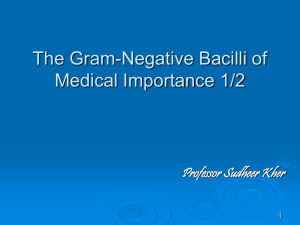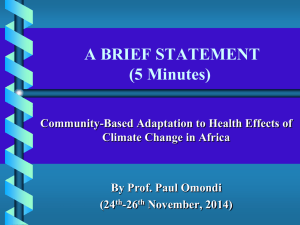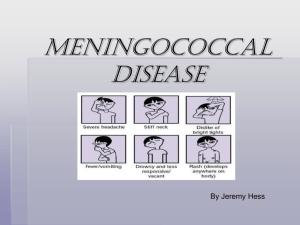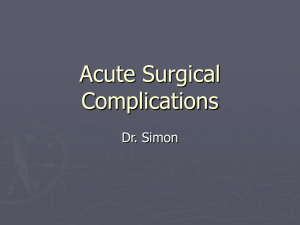PowerPoint
advertisement
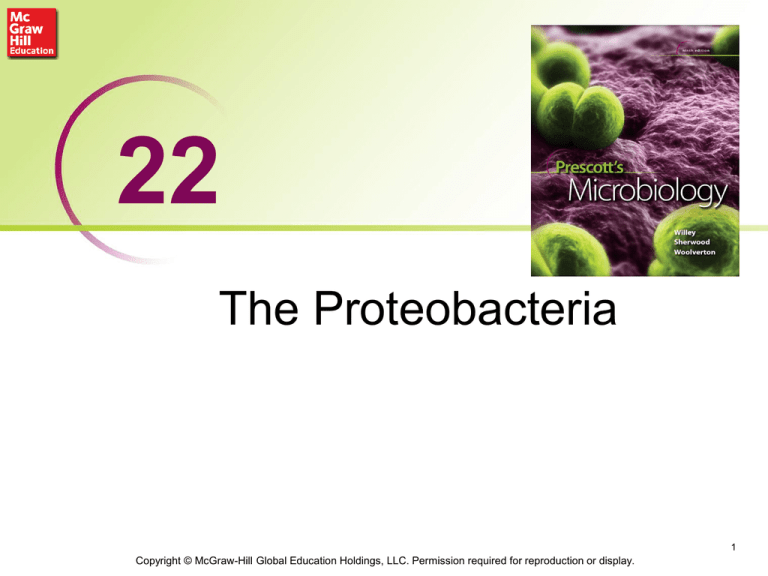
22 The Proteobacteria 1 Copyright © McGraw-Hill Global Education Holdings, LLC. Permission required for reproduction or display. The Proteobacteria • The largest phylogenetically coherent bacterial group with more than 500 genera • Remarkable diverse morphologically, physiologically, and other ways • Volume 2 of Bergey’s Manual (2nd edition) is devoted to this group of bacteria 2 The Rickettsia • Genus Rickettsia • Very small • All species are parasitic or mutualistic – grows in vertebrate erythrocytes, macrophages, vascular endothelial cells – live in blood sucking arthropods – vectors or primary hosts • Produces only a small amount of ATP 3 Rickettsia... • Genome sequence similar to mitochondria – arose from endosymbiotic association • free living, aerobic bacterium became intracellular parasite of proto-eukaryotic cell that lacked organelles • gene reduction occurred and loss of free living ability • Lack glycolytic pathway - do not use glucose as energy source • Take up and use ATP and other materials from host cell 4 Important Pathogens • Rickettsia prowazekii and Rickettsia typhi – typhus fever • Rickettsia rickettsii – Rocky Mountain Spotted Fever • Reproduction – enters host by phagocytosis – escapes phagosome – reproduces in cytoplasm – host cell bursts 5 Rocky Mountain Spotted Fever • Caused by Rickettsia rickettsii • Transmitted by ticks – transovarian passage – transmission of bacteria from generation to generation of ticks through their eggs – passage by tick feeding or by defecation of tick and rubbed into skin • Rickettsias reproduce in endothelial cells and macrophages 6 Rocky Mountain Spotted Fever • Clinical manifestations – vasculitis and sudden onset of headache, high fever, chills, and skin rash – can destroy blood vessels in heart, lungs, or kidneys, leading to death • Diagnosis – observation of signs and symptoms, and serological tests • Treatment, prevention, and control – antibiotic therapy and symptomatic/supportive therapy – tick control and avoidance of ticks 7 The Caulobacteraceae • rods or cocci with an appendage • life cycle – prostheca (pl., prosthecae) or stalk • extension of cell, including plasma membrane, that is narrower than mature cell – reproduction by budding • progeny cell is a bud that first appears as a small protrusion on parent cell and enlarges to form mature cell 8 Genus Caulobacter • May be polarly flagellated rods or may possess prostheca and holdfast – used to attach to solid substrata with what is known as the strongest biological adhesion molecule • Strongest biological adhesive known – much stronger than super glue or dental adhesive 9 Genus Caulobacter • Usually found in aquatic and terrestrial habitats – may absorb nutrients released from hosts – long prosthecae may improve nutrient uptake • Reproduction – asymmetric transverse binary fission 10 Genus Rhizobium • Gram-negative, pleomorphic, motile rods • Grow symbiotically as nitrogen-fixing bacteroids within root nodule cells of legumes – most successful plant family on earth 11 Genus Brucella • Important human and animal pathogen – undulant fever – zoonosis • Caused by Brucella species (B. abortus, B. melitensis, B. ovis, B. suis, or B. canis) (Select Agents) • Human infection – ingestion of Brucella contaminated food, raw milk or water – inhalation of organism – bacterial entry into body through skin wounds 12 Brucellosis (Undulant Fever) • Presents as non-specific, flu-like symptoms • In undulant form, symptoms include undulant fevers, arthritis, and testicular inflammation in males • In chronic form, symptoms include chronic fatigue syndrome, depression, and arthritis 13 Genus Neisseria… • May have capsules and fimbriae • gram-negative cocci • aerobic chemoorganotrophs • oxidase positive and usually catalase positive • Inhabitants of mucous membranes of mammals – some human pathogens • Neisseria meningitidis – meningitis • Neisseria gonorrhoeae – gonorrhea 14 Meningitis • Inflammation the brain or spinal cord meninges • Many causes including bacterial – bacterial may be diagnosed by Gram stain of cerebrospinal fluid (CSF) – culture of CSF may or may not grow bacteria • Major bacterial causes include – Streptococcus pneumoniae, Neisseria meningitidis (serotypes), and Haemophilus influenza (serotype b) – may be endogenous infection (normal biota) • N. meningitidis (meningococcus) causes epidemic meningitis 15 Gonorrhea • Caused by Neisseria gonorrhoeae – Gram-negative, oxidasepositive diplococcus – referred to as gonococcus • Disease of mucous membranes of the genitourinary tract, eye, rectum, and throat • Can also be transmitted from mother to child during birth, causing – ophthalmia neonatorum (conjunctivitis of the newborn) 16 The Burkholderiales • Well-known genera – Burkholderia, Bordetella, Sphaerotilus, and Leptothrix • Some members have a sheath – hollow tubelike structure surrounding chain of cells – may contain ferric or manganic oxides – functions • attachment to surfaces • obtaining nutrients from slowly running water • protection against predators 17 Burkholderia cepacia • Degrades >100 organic molecules – very active in recycling organic material • Plant pathogen • Has become a major nosocomial pathogen – particular problem for cystic fibrosis patients • Outbreaks in mouthwash and medications, such as Tylenol 18 Genus Bordetella • Gram-negative coccobacilli – some have capsules • Aerobic chemoorganotrophs – respiratory metabolism – require organic sulfur and amino acids for growth • Mammalian parasites that multiply in respiratory epithelial cells – nonmotile, encapsulated species – whooping cough and kennel cough 19 Pertussis • Whooping cough – caused by Gram-neg Bordetella pertussis – highly contagious disease that primarily affects children • Transmission by droplet inhalation • Toxins: – pertussis toxin most important toxin • stops protein synthesis – tracheal cytotoxin, dermonecrotric toxin • destroy epithelial tissue 20 Pertussis • Clinical manifestations – 7- to 14-day incubation – initial coldlike symptoms /inflamed mucous membranes – followed by prolonged coughing sieges with inspiratory whoop – permanent or long-lasting immunity develops • Treatment, prevention, and control – bacterial culture, fluorescent antibody staining, and serological tests – antibiotic therapy – immunization with DPT for younger or Tdap acellular vaccines for older children and adults 21 Genus Thiobacillus • Found in soil and aquatic habitats – production of sulfuric acid can cause corrosion of concrete and metal structures – may increase soil fertility by releasing sulfate – used in leaching metals from low grade metal ores 22 Genus Thiomargarita • Among largest bacteria • Over 100 microns in diameter and hundreds of centimeters long • Beggiatoa, Thioploca, Thiomargarita grow in bundles, appear hollow 23 The Legionellaceae • Family Legionellacaea – genus Legionella • Family Coxiellaceae – genera Coxiella and Rickettsiella • All are intracellular pathogens – dimorphic lifestyle (two forms) 24 Genus Legionella • L. pneumophilia intensely studied – causative agent Legionnaire’s disease – transmission through aerosols – intracellular pathogen of protozoa • invade cooling towers, air conditioning, hot tubs – Gram-negative rods that replicates by binary fission 25 Legionnaires’ Disease and Pontiac Fever • Caused by Legionella pneumophila – fastidious, Gram-negative rod – harbored by free-living amoebae and ciliated protozoa • Spread by airborne transmission from environmental reservoir to human host – soil, aquatic ecosystems, air-conditioning systems, and shower stalls 26 Legionnaires’ Disease (Legionellosis) • Reproduction of bacterium in alveolar macrophages causes localized tissue destruction – produce cytotoxic exoprotease • Clinical manifestations – fever, cough, headache, neuralgia, and bronchopneumonia – severe in immunocompromised • Treatment, prevention, and control – isolation of bacteria and immunodiagnostics – symptomatic/supportive therapy and antibiotic therapy – eliminate nosocomial spread – Identification/elimination of environmental source 27 Genus Coxiella • Host range – birds, insects, fish, rodents, sheep, goats, humans • Transmitted through aerosol • Life cycle similar to L. pneumophilia – small cell variant (SCV) enters cell by phagocytosis – phagosome low pH triggers SCV to become metabolically active – SCV differentiates into large cell variant (LCV) – replicates by binary fission, are infectious – long-term survival outside the host 28 Q Fever (Select Agent) • Caused by Coxiella burnetii – intracellular Gram-negative bacterium – proliferates in lungs – survives outside host by forming endospore-like body • Transmitted by – ticks between animals – contaminated dust to humans – occupational hazard among slaughterhouse workers, farmers, and veterinarians 29 Pseudomonas aeruginosa • Widely found in the environments • Common cause of “Swimmer’s ear,” folliculitis and other rashes, urinary tract infections – Can be picked up by poorly maintained swimming pools and spas • One of the most common causes of nosocomial infections – 4th most common 2013 (most common in hosp stays over 1 week) – 5% entering hosp fecal carriers, after 72 hrs in hosp 20% carriers • “Extremely high fatality rate” in pneumonia, sepsis, burn infections and meningitis • Frequently antibiotic resistant • Produce siderophores that scavenge and bind to iron (pyoverdine – yellow green, pycocyanin – blue) 30 Practical Importance of Pseudomonads • Degrade wide variety of organic molecules – mineralization - microbial breakdown of organic materials to inorganic substrates – use in bioremediation – found in environments such as disinfectants, bottled mineral water, adhesives in caps, soap residues • Some are major animal and plant pathogens • Some cause spoilage of refrigerated food – can grow at 4°C 31 Cholera • Caused by Vibrio cholerae, a commashaped, Gram-negative bacterium • Acquired by ingesting food or water contaminated by fecal matter from patients or carriers • Shellfish are natural reservoirs • Organisms adhere to intestinal mucosa of small intestine and secrete the toxin choleragen 32 Cholera • Presence of toxin results in massive loss of water and electrolytes – production of “rice-water stools” • Diagnosis – culture from feces with subsequent identification by agglutination reactions • Treatment, control, and prevention – oral rehydration – antibiotic therapy 33 V. vulnificus and V. parahaemolyticus • Both are infections that increase during the summer months because the organism thrives in warmer ocean waters of Gulf coast, however the incidence has spread to colder waters of the north, possible effect of global warming • Raw oysters are the biggest risk, also wounds infected from ocean water • V. parhaemolyticus had a 43% increase in infection reported in 2012 by CDC, they estimate 142 cases not reported for every reported case • In 2010 CDC reported Vibrio case up 115% • High fatality rate in compromised people, including diabetics 34 V. fischeri, V. harveyi • Free-living • Capable of bioluminescence – emission of light catalyzed by luciferase – symbiotic relationship with fish organs – also observed in at least two species of Photobacterium 35 Order Enterobacteriales • One family, Enterobacteriaceae; 44 genera – enteric bacteria or enterobacteria • Facultative anaerobes • Very common, widespread, and important • Chemoorganotrophs degrade sugars – majority are mixed acid fermenters – others are butanediol fermenters 36 Escherichia coli • Probably best studied bacterium • Inhabitant of intestinal tracts of many animals • Used as indicator organisms for testing water for fecal contamination • Some strains are pathogenic – gastroenteritis – urinary tract infections 37 Important Pathogenic Enteric Bacteria • Salmonella – typhoid fever and gastroenteritis • Shigella – bacillary dysentery • Klebsiella – pneumonia • Yersinia pestis – plague • Yersinia enterocolitica – G.I. illness • Erwinia – blights, wilts, etc., of crop plants 38 Escherichia coli Gastroenteritis • Traveler’s diarrhea – caused by certain viruses, bacteria, or protozoa normally absent from traveler’s environment – E. coli is one of major causative agents • E. coli 0157:H7 and other STECs (Shigatoxin producing E.coli) – cause more severe infections associated with fecal contamination • Part of normal flora of intestines and normally not pathogenic 39 Pathogenic E. coli Strains • Enterotoxigenic E. coli (ETEC) – produces one or both enterotoxins responsible for diarrhea – distinguished by their heat stability • Enteroinvasive E. coli (EIEC) – multiplies within intestinal epithelial cells – may produce a cytotoxin and an enterotoxin • Enteropathogenic E. coli (EPEC) – causes effacing lesions • caused by destruction of brush border microvilli on intestinal epithelial cells 40 Pathogenic E. coli Strains • Enterohemorrhagic E. coli (EHEC) – produces effacing lesions and hemorrhagic colitis – releases shiga-like toxins • Enteroaggregative E. coli (EAEC) – forms clumps adhering to epithelial cells • “stacked brick” appearance – toxins have not been identified • Diffusely adhering E. coli (DAEC) – adheres in a uniform pattern to epithelial cells – particular problem in immunologically naïve or malnourished children 41 Salmonellosis • Caused by >2,000 Salmonella serovars, Gram-negative non-spore forming rods • Transmitted to humans by contaminated foods such as beef products, poultry, egg products, and water • Disease results from food-borne infection – bacteria in intestinal mucosa produce enterotoxin and cytotoxin 42 Salmonellosis • Symptoms include abdominal, pain, cramps, diarrhea, nausea, vomiting, and fever • Diagnosis – isolation of organism from food or patients’ stools • Treatment, control, and prevention – fluid and electrolyte replacement – good food handling practices, proper refrigeration, adequate cooking 43 Typhoid Fever • Caused by Salmonella enterica subspecies enterica serovar Typhi, a Gram-negative rod • Acquired by ingestion of food or water contaminated by feces in infected humans or person-to-person contact • Paratyphoid fever – milder form of disease 44 Typhoid Fever • Bacteria spread from small intestine to lymphoid tissue, blood, liver, and gallbladder • Symptoms include fever, headache, abdominal pain, anorexia, and malaise • In carriers (e.g., Typhoid Mary) bacteria grow in gallbladder and reach intestine through bile duct 45 Typhoid Fever • Diagnosis – demonstration of typhoid bacilli in blood, urine, or stools – serology (Widal test) • Treatment, prevention, and control – antibiotic therapy – vaccine for high risk individuals – purification of drinking water, prevention of food handling by carriers, and isolation of patients 46 Shigellosis • Bacillary dysentery – caused by four species of genus Shigella – gram-negative, non-spore forming rods – intracellular parasites, multiply in colonic epithelium – cause inflammatory reaction in mucosa – humans are the only host 47 Virulence in Shigellosis • Endotoxin • Exotoxins play role in disease progression – shiga toxin – targets glomerular epithelium and may lead to kidney failure • Type III secretion system delivers virulence factors into epithelial cells 48 Shigellosis • Watery stools often contain blood, mucus, and pus • Diagnosis – biochemical characteristics – serology • Treatment, prevention, and control – antibiotic therapy – prevention by use of good personal hygiene and a clean water supply 49 Plague • Yersinia pestis – Gram-negative • Transmission rodent to human – bite of infected flea, direct contact with infected animal or product, inhalation contaminated airborne droplets • In body, multiply in blood and lymph – survive and proliferate in phagocytic cells – enlarged lymph nodes (buboes) 50 51 Plague • Virulence factor – proliferates in phagocytes, not killed – type III secretion systems deliver yersinal outer membrane proteins (YOPS) into cells which shut down defense mechanisms • Y. pestis is Select agent – potential bioterrorism threat 52 Plague • Clinical manifestations – subcutaneous hemorrhages, fever, and buboes (hence name bubonic plague) – high mortality if untreated – pneumonic plague arises from: • primary exposure to infectious respiratory droplets of infected persons or cats • secondary to hematogenous spread in a patient with bubonic plague 53 Plague • Diagnosis made in reference labs which use direct microscopic examination, culture and serological tests, and PCR • Treatment, prevention, and control – antibiotic therapy – ectoparasite and rodent control, isolation of human patients, prophylaxis of exposed persons, immunization of persons at high risk 54 Order Bdellovibrionales • One family, Bdellovibrionaceae; four genera – best studied is Bdellovibrio • aerobic, Gram-negative, motile curved rods • predatory bacteria life cycle that resembles bacteriophages, also studied in treatment of infections 55 Order Myxococcales • Contains five families distinguished based on shape of vegetative cells, myxospores, and sporangia, develop fruiting bodies • Gram-negative, rod-shaped gliding bacteria 56 • Distinctive life cycle resembling that of cellular slime molds Myxobacteria • In presence of food form a swarm and glide on solid surfaces using slime • Form a fruiting body when nutrients exhausted 57 Myxospores • Frequently enclosed in walled structures called sporangioles (sporangia) • Dormant and desiccation-resistant – may survive up to 10 years 58 Campylobacter jejuni formerly C. fetus • reproductive disease, abortions in cattle and sheep • carried by birds – studies show 20-100% of all retail chicken contaminated – raw milk is significant source of outbreaks • septicemia and enteritis in humans – septicemia – pathogens or their toxins in blood – enteritis – inflammation of intestinal tract • one of most common food-borne illness in U.S. – causes more than Shigella and Salmonella combined, CDC reports 14% increase in 2012 – low infective dose 59 Genus Helicobacter • At least 23 species isolated from stomachs and upper intestines of mammals • e.g., Helicobacter pylori – causes gastritis and peptic ulcer disease – motility important for colonization – does not grow below pH 4.5 • urease converts urea to ammonia and CO2 – urea hydrolysis appears to be associated with virulence 60

